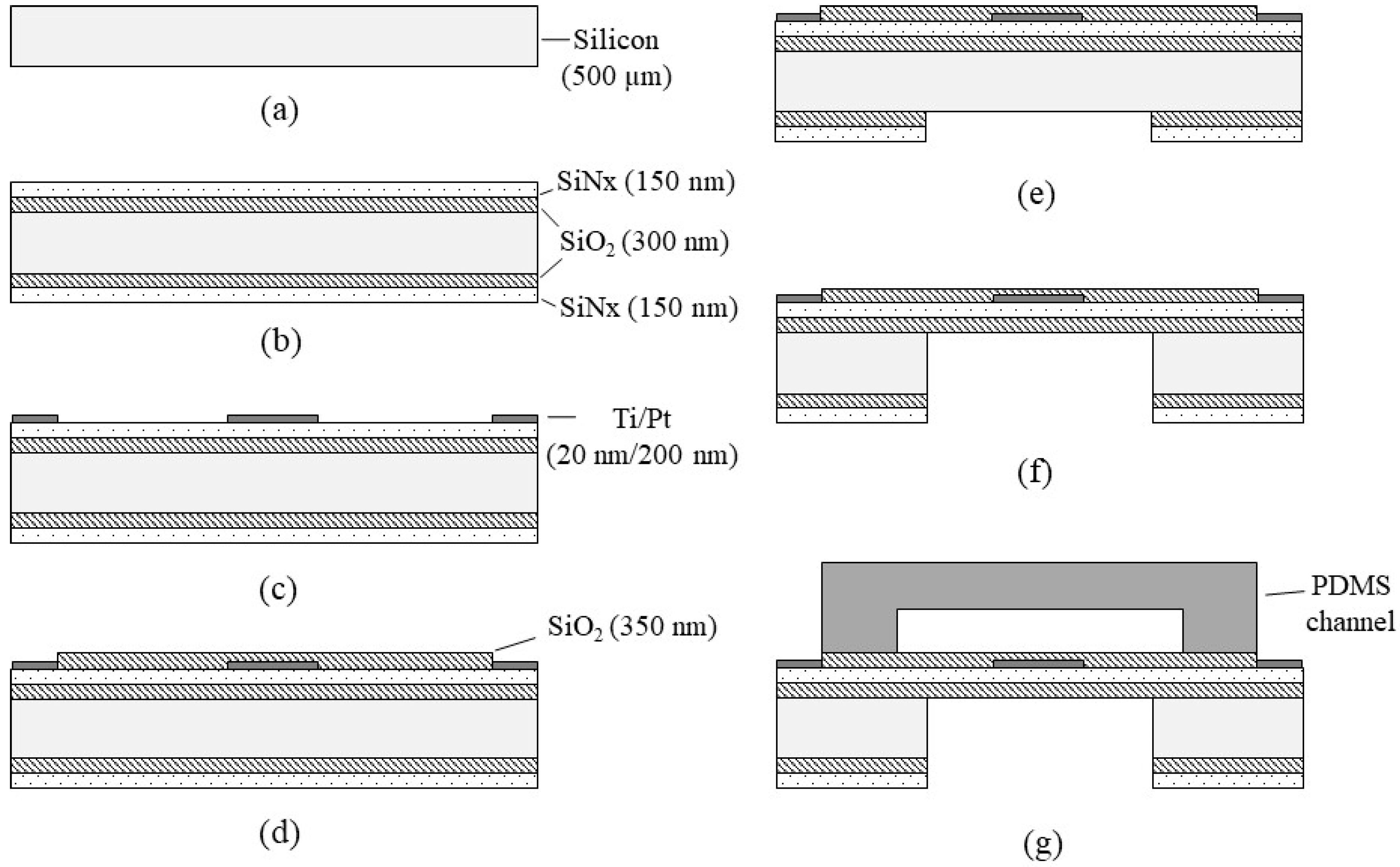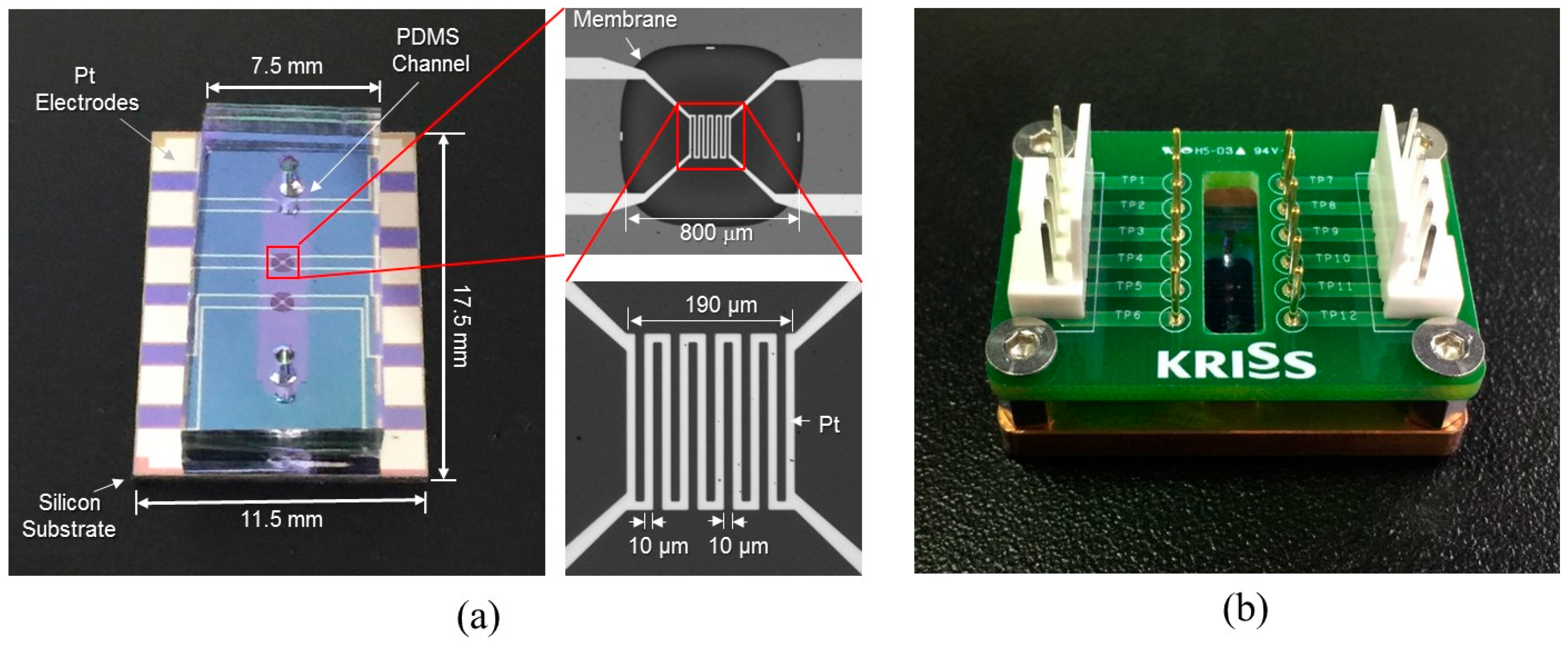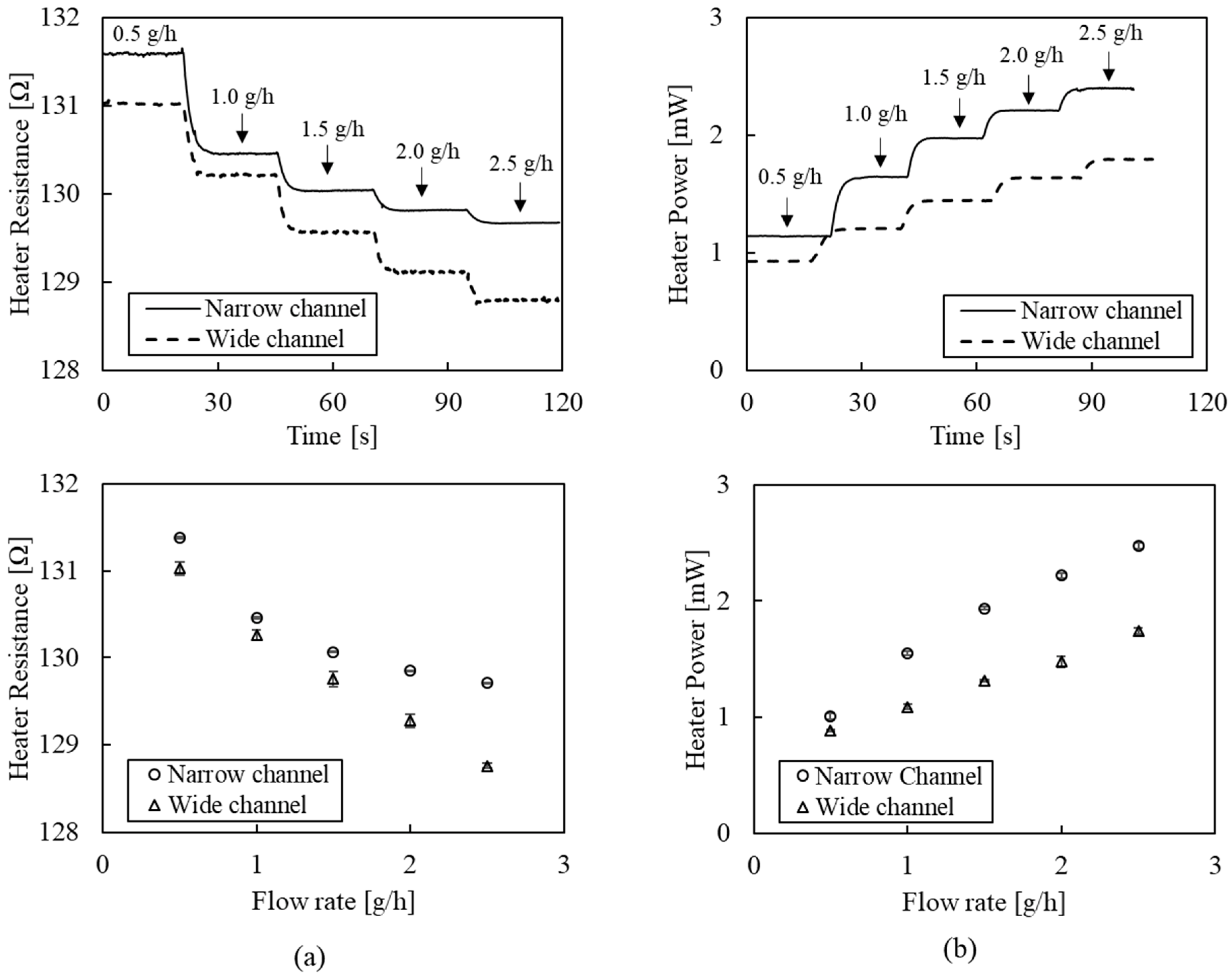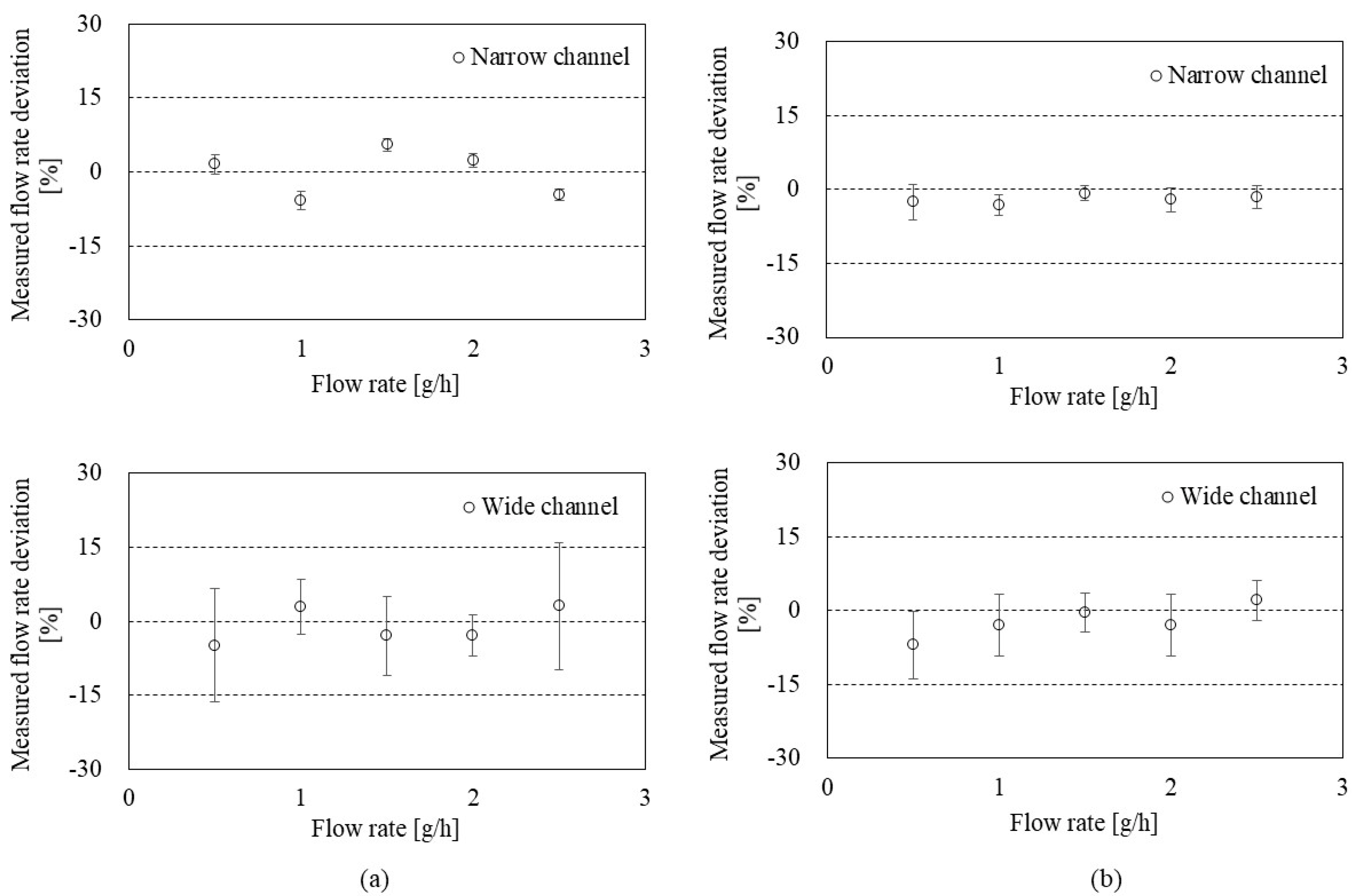Microfluidic Thermal Flowmeters for Drug Injection Monitoring
Abstract
:1. Introduction
2. Materials and Methods
2.1. Working Principle and Design
2.2. Fabrication Process
2.3. Thermal Flowmeter Characterization Setup
3. Results
4. Discussion
5. Conclusions
Author Contributions
Funding
Institutional Review Board Statement
Informed Consent Statement
Data Availability Statement
Conflicts of Interest
References
- Batista, E.; Almeida, N.; Filipe, E.; Costa, A. Calibration and use of syringe pumps. In Proceedings of the 16th International Congress of Metrology, Paris, France, 7–10 October 2013; p. 02007. [Google Scholar]
- Hagihghi, R.; Razmjou, A.; Orooji, Y.; Warkiani, M.E.; Asadnia, M. A miniaturized piezoresistive flow sensor for real-time monitoring of intravenous infusion. J. Biomed. Mater. Res. Part B Appl. Biomater. 2020, 108, 568–576. [Google Scholar] [CrossRef] [PubMed]
- Weinger, M.B.; Kline, A. Reflections on the Current State of Infusion Therapy. Biomed. Instrum. Technol. 2016, 50, 253–262. [Google Scholar] [CrossRef] [PubMed]
- Jahn, L.G.; Capurro, J.J.; Levy, B.L. Comparative dose accuracy of durable and patch insulin infusion pumps. J. Diabetes Sci. Technol. 2013, 7, 1011–1020. [Google Scholar] [CrossRef] [PubMed] [Green Version]
- Weiss, M.; Gerber, S.; Füchslin, R.M.; Neff, T.A. Accurate continuous drug delivery at low infusion rate with a novel microvolumetric infusion pump (MVIP): Pump design, evaluation and comparison to the current standard. Anaesthesia 2004, 59, 1133–1137. [Google Scholar] [CrossRef] [Green Version]
- Batliner, M.; Weiss, M.; Dual, S.A.; Grass, B.; Meboldt, M.; Schmid Daners, M. Evaluation of a novel flow-controlled syringe infusion pump for precise and continuous drug delivery at low flow rates: A laboratory study. Anaesthesia 2019, 74, 1425–1431. [Google Scholar] [CrossRef]
- Guelig, D.; Bauer, J.; Wollen, A.; Schiller, C.; Sherman-Konkle, J.; Roche, A.; Weyrauch, K.; Eisenstein, M. Design of a novel, adjustable flow rate, reusable, electricity-free, low-cost syringe infusion pump. J. Med. Devices Trans. ASME 2017, 11, 041006. [Google Scholar] [CrossRef] [Green Version]
- Baeckert, M.; Batliner, M.; Grass, B.; Buehler, P.K.; Daners, M.S.; Meboldt, M.; Weiss, M. Performance of modern syringe infusion pump assemblies at low infusion rates in the perioperative setting. Br. J. Anaesth. 2020, 124, 173–182. [Google Scholar] [CrossRef]
- Clarkson, D.M. Accuracy estimations of testing of infusion devices using weighing balances. Med. Eng. Phys. 2002, 24, 229–235. [Google Scholar] [CrossRef]
- Ejeian, F.; Azadi, S.; Razmjou, A.; Orooji, Y.; Kottapalli, A.; Ebrahimi Warkiani, M.; Asadnia, M. Design and applications of MEMS flow sensors: A review. Sens. Actuators A Phys. 2019, 295, 483–502. [Google Scholar] [CrossRef]
- Araújo, F.M.; Santos, J.L.; Ferreira, L.A.; Frazão, O.; Caldas, P. Optical flowmeter using a modal interferometer based on a single nonadiabatic fiber taper. Opt. Lett. 2007, 32, 1974–1976. [Google Scholar] [CrossRef]
- Arumuru, V.; Dash, J.N.; Dora, D.; Jha, R. Vortex Shedding Optical Flowmeter based on Photonic Crystal Fiber. Sci. Rep. 2019, 9, 1–9. [Google Scholar] [CrossRef] [Green Version]
- Wang, Y.H.; Lee, C.Y.; Chiang, C.M. A MEMS-based Air Flow Sensor with a Free-standing Micro-cantilever Structure. Sensors 2007, 7, 2389–2401. [Google Scholar] [CrossRef] [Green Version]
- Noeth, N.; Keller, S.S.; Boisen, A. Fabrication of a cantilever-based microfluidic flow meter with nL min−1 resolution. J. Micromech. Microeng. 2010, 21, 015007. [Google Scholar] [CrossRef]
- Czaplewski, D.A.; Ilic, B.R.; Zalalutdinov, M.; Olbricht, W.L.; Zehnder, A.T.; Craighead, H.G.; Michalske, T.A. A micromechanical flow sensor for microfluidic applications. J. Microelectromechan. Syst. 2004, 13, 576–585. [Google Scholar] [CrossRef]
- Kim, T.H.; Kim, S.J. Development of a micro-thermal flow sensor with thin-film thermocouples. J. Micromech. Microeng. 2006, 16, 2502. [Google Scholar] [CrossRef]
- Shin, W.C.; Besser, R.S. A micromachined thin-film gas flow sensor for microchemical reactors. J. Micromech. Microeng. 2006, 16, 731. [Google Scholar] [CrossRef]
- Elwenspoek, M. Thermal flow micro sensors. Proc. Int. Semicond. Conf. CAS 1999, 2, 423–435. [Google Scholar] [CrossRef] [Green Version]
- Lee, D.; Kim, J.; Park, Y.; Lee, K.H.; Kim, C.; Kwon, O.; Kim, S.; Lee, S.R. Sensitive and reliable thermal micro-flow sensor for a drug infusion system. Sens. Actuators A Phys. 2020, 309, 112033. [Google Scholar] [CrossRef]
- Meng, E.; Li, P.Y.; Tai, Y.C. A biocompatible Parylene thermal flow sensing array. Sens. Actuators A Phys. 2008, 144, 18–28. [Google Scholar] [CrossRef]
- Balakrishnan, V.; Phan, H.P.; Dinh, T.; Dao, D.V.; Nguyen, N.T. Thermal Flow Sensors for Harsh Environments. Sensors 2017, 17, 2061. [Google Scholar] [CrossRef] [Green Version]
- Nguyen, N.T.; Kiehnscherf, R. Low-cost silicon sensors for mass flow measurement of liquids and gases. Sens. Actuators A Phys. 1995, 49, 17–20. [Google Scholar] [CrossRef]
- Ahrens, R.; Schlote-Holubek, K. A micro flow sensor from a polymer for gases and liquids. J. Micromech. Microeng. 2009, 19, 074006. [Google Scholar] [CrossRef]
- Nguyen, N.T. Micromachined flow sensors—A review. Flow Meas. Instrum. 1997, 8, 7–16. [Google Scholar] [CrossRef]
- Roh, S.C.; Choi, Y.M.; Kim, S.Y. Sensitivity enhancement of a silicon micro-machined thermal flow sensor. Sens. Actuators A Phys. 2006, 128, 1–6. [Google Scholar] [CrossRef]
- Shimohira, C.; Hasegawa, Y.; Taniguchi, K.; Matsushima, M.; Kawabe, T.; Shikida, M. Development of micromachined flow sensor for drip infusion system. Microsyst. Technol. 2020, 26, 3677–3683. [Google Scholar] [CrossRef]
- Kuo, J.T.W.; Yu, L.; Meng, E. Micromachined thermal flow sensors—A review. Micromachines 2012, 3, 550–573. [Google Scholar] [CrossRef] [Green Version]
- Morganti, E.; Collini, C.; Lorenzelli, L.; Borghetti, F.; Stoppa, D.; Gonzo, L. A micro-reactor array for fluorescence markers-based bioaffinity assays. Procedia Chem. 2009, 1, 1087–1090. [Google Scholar] [CrossRef]
- Sim, J.K.; Hyun, J.; Doh, I.; Ahn, B.; Kim, Y.T. Thin-film resistance temperature detector array for the measurement of temperature distribution inside a phantom. Metrologia 2018, 55, L5–L11. [Google Scholar] [CrossRef] [Green Version]
- Lee, S.H.; Park, S.; Lee, J.; Kang, W. Practical methodology for in situ measurement of micro flow rates using laser diode absorption sensors. Metrologia 2019, 56, 045010. [Google Scholar] [CrossRef]
- Ilfeld, B.M.; Morey, T.E.; Enneking, F.K. The delivery rate accuracy of portable infusion pumps used for continuous regional analgesia. Anesth. Analg. 2002, 95, 1331–1336. [Google Scholar] [CrossRef]







Publisher’s Note: MDPI stays neutral with regard to jurisdictional claims in published maps and institutional affiliations. |
© 2022 by the authors. Licensee MDPI, Basel, Switzerland. This article is an open access article distributed under the terms and conditions of the Creative Commons Attribution (CC BY) license (https://creativecommons.org/licenses/by/4.0/).
Share and Cite
Doh, I.; Sim, D.; Kim, S.S. Microfluidic Thermal Flowmeters for Drug Injection Monitoring. Sensors 2022, 22, 3151. https://doi.org/10.3390/s22093151
Doh I, Sim D, Kim SS. Microfluidic Thermal Flowmeters for Drug Injection Monitoring. Sensors. 2022; 22(9):3151. https://doi.org/10.3390/s22093151
Chicago/Turabian StyleDoh, Il, Daniel Sim, and Steve S. Kim. 2022. "Microfluidic Thermal Flowmeters for Drug Injection Monitoring" Sensors 22, no. 9: 3151. https://doi.org/10.3390/s22093151





